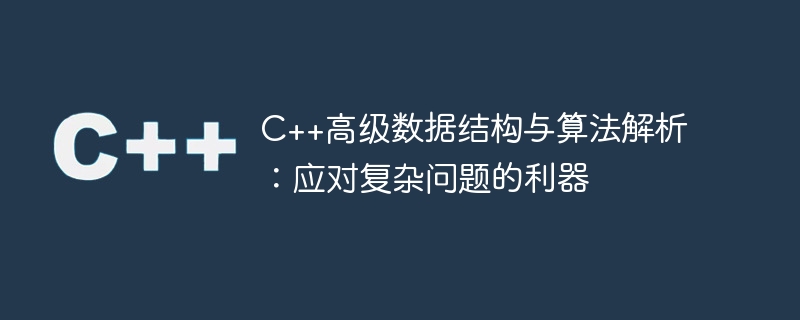Home >Backend Development >C++ >C++ advanced data structure and algorithm analysis: a powerful tool for dealing with complex problems
C++ advanced data structure and algorithm analysis: a powerful tool for dealing with complex problems
- 王林Original
- 2023-11-27 08:24:251486browse

C Advanced data structure and algorithm analysis: a powerful tool to deal with complex problems
With the rapid development of information technology, people's data processing needs are becoming more and more complex. . Processing large-scale data and solving complex problems have become important tasks in the field of software development. As one of the powerful tools to deal with these challenges, advanced data structures and algorithms have always attracted much attention.
As an efficient and flexible programming language, C has a rich data structure and algorithm library, providing developers with powerful tools to solve complex problems. This article will introduce several common advanced data structures and algorithms and explore their application in solving practical problems.
First, let’s learn about red-black trees. The red-black tree is a self-balancing binary search tree that can perform insertion, deletion and search operations in O(log n) time. It maintains the balance of the tree through special marking of node colors. Red-black trees are widely used to implement data structures such as ordered sets and ordered maps, such as map and set in the C standard library. By using red-black trees, we can efficiently process large amounts of ordered data and improve program performance and efficiency.
In addition to red-black trees, AVL trees are also a common balanced binary search tree. Compared with red-black trees, AVL trees require that the height of the tree be kept within a smaller range after inserting or deleting nodes, thus maintaining a stricter balance. The AVL tree may be more efficient than the red-black tree in some cases, but the time complexity of its insertion and deletion operations is O(log n). In comparison, the red-black tree has a slight advantage in the insertion and deletion operations. . Developers can choose a suitable balanced binary search tree based on the needs of specific problems.
In addition to balanced binary search trees, C also provides a variety of other advanced data structures and algorithms. For example, a hash table is a data structure based on a hash function that enables insertion, deletion, and lookup operations in constant time. Hash tables are a very efficient choice when solving problems that require fast lookups. The C standard library provides implementations of hash tables such as unordered_map and unordered_set.
In addition, graph is a common data structure, which is very useful when solving problems such as network and path planning. C provides graph representation and operations based on adjacency matrix and adjacency list. Using graph theory algorithms, we can solve a series of practical problems such as shortest paths, minimum spanning trees, etc.
In addition to data structures, C also provides a rich algorithm library. For example, sorting algorithms are indispensable tools for solving data sorting problems. C's standard library provides various sorting algorithms, including quick sort, merge sort, heap sort, etc. In addition, search algorithms are also key to dealing with complex problems. C provides common search algorithms such as breadth-first search and depth-first search, which can solve applications such as maze problems and artificial intelligence.
In summary, C advanced data structures and algorithms provide us with powerful tools for dealing with complex problems. Whether it is processing large-scale data, solving efficient search problems, or solving practical applications such as path planning and network analysis, these advanced data structures and algorithms can help us complete tasks in a more efficient way. As developers, learning and mastering these tools will enable us to better deal with complex problems and improve programming skills and efficiency.
The above is the detailed content of C++ advanced data structure and algorithm analysis: a powerful tool for dealing with complex problems. For more information, please follow other related articles on the PHP Chinese website!

